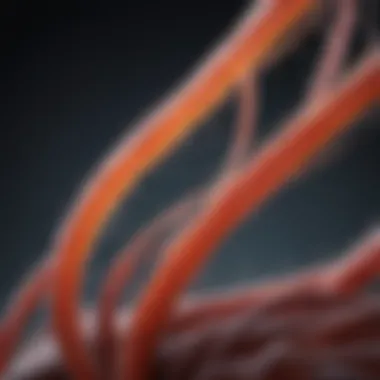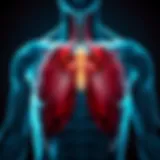Comparative Analysis of 3D Filaments: In-Depth Review


Summary of Objectives
This section aims to provide a thorough overview of the various properties and applications of 3D printing filaments. Understanding the nuanced features of each filament type is critical for end-users. With this knowledge, users can make informed decisions that enhance the efficiency and quality of their 3D printing projects.
Importance of the Research
3D printing has revolutionized manufacturing and design. However, the success of any project hinges on selecting the right materials. This analysis serves as a guide, highlighting key characteristics of filaments. It also addresses their practical implications in real-world applications, allowing researchers and professionals to optimize their work.
Prelims
The advent of 3D printing has propelled the additive manufacturing sector into a new era. As various industries embrace this technology, understanding filament types becomes paramount. Each filament carries unique attributes that influence the final product's quality, durability, and functionality. The focus of this article is to demystify these materials and present a comparative analysis.
Types of 3D Printing Filaments
3D printing filaments come in different varieties, each suited for specific purposes. Common options include:
- PLA (Polylactic Acid)
Biodegradable and user-friendly, PLA is often recommended for beginners. Its low melting point enables quick printing but limits its temperature resistance in practical applications. - ABS (Acrylonitrile Butadiene Styrene)
Known for its strength and impact resistance, ABS is widely used in commercial products. However, it requires a heated print bed to minimize warping. - PETG (Polyethylene Terephthalate Glycol)
PETG combines the ease of printing found in PLA with the durability of ABS. It is resistant to moisture and chemicals, making it versatile for various applications.
Advanced options include Nylon, TPU, and carbon fiber composites. Each of these materials requires nuanced handling and specific printer settings.
Results and Discussion
Presentation of Findings
Comparative analysis reveals distinct advantages and disadvantages for each filament type. For instance, while PLA is easier to print, it cannot withstand high temperatures like ABS. PETG, on the other hand, excels in moisture resistance without compromising print quality.
"Choosing the right filament is as vital as selecting a printer itself. Each filament's unique properties define the printing process and final product attributes."
Implications of Results
The findings suggest that users should carefully consider their project requirements before choosing a filament. A mismatch can lead to subpar results or even project failure. This research underscores the importance of understanding filament properties, thereby enhancing the decision-making process.
Epilogue
Preamble to 3D Filaments
The realm of 3D printing has transformed various industries, providing significant advancements in manufacturing, prototyping, and even healthcare. Central to this technology are the materials known as 3D filaments, which play a crucial role in determining the quality of printed objects. Without a proper understanding of these filaments, users may face challenges that hinder the overall efficiency and effectiveness of their projects. This section lays the foundation for exploring the types of 3D filaments available and highlights the potential they offer in diverse applications.
The choice of filament influences several aspects of the printing process: from the mechanical properties of the final product to its aesthetic qualities. Knowledge of different filament characteristics allows users to make informed decisions that align with their specific requirements.
Definition and Importance
3D filaments are the raw materials used in the additive manufacturing process of 3D printing. They are supplied in spools and come in various compositions, each with distinct properties. Understanding the definition of these materials is essential for users aiming to leverage 3D printing effectively.
Importance of 3D Filaments:
- Material Properties: Different filaments possess unique properties like strength, durability, and flexibility. These characteristics determine the suitability of a filament for specific applications.
- Performance Optimization: Knowledge of filament types can help in optimizing the performance of the 3D printer itself. Using compatible filaments can reduce print failures and improve print quality.
- Wider Application Range: With diverse 3D filaments available, industries can explore new applications ranging from functional prototypes to intricate art pieces.
Overview of 3D Printing Technology
3D printing, or additive manufacturing, is a process that creates three-dimensional objects from digital models. Unlike traditional manufacturing methods that often involve subtractive processes, 3D printing constructs items layer by layer. This technology encompasses several stages, beginning with designing a model in CAD software, followed by slicing the model into layers, and finally printing it using a suitable filament.
The evolution of 3D printing is marked by advancements in both printers and filaments. Initially limited to simple shapes, the technology now enables the production of complex geometries with high precision.
Key aspects of this technology include:
- Layer-by-layer construction: This method allows for the creation of intricate designs that are impossible with traditional techniques.
- Material Diversity: The range of available filaments has expanded significantly, giving rise to varied applications across sectors such as aerospace, automotive, and healthcare.
- Rapid Prototyping: 3D printing enables the swift production of prototypes, allowing for faster iterations and reduced time-to-market for products.
In summary, the combination of understanding 3D filaments and the technology behind 3D printing provides users with the necessary tools to maximize their innovation potential. By assessing both properties and applications of different filaments, users can enhance their projects and make informed decisions.
Types of 3D Filaments
The selection of the appropriate type of 3D filament is central to the success of any additive manufacturing project. Each filament type brings distinct attributes that can greatly influenc the final product's quality, usability, and overall performance. Understanding the different categories, such as thermoplastics, biodegradable filaments, and composite filaments, allows users to make informed choices. This section focuses on these types, exploring their properties, benefits, and considerations that are essential for effective 3D printing.


Thermoplastics
Thermoplastics are among the most commonly used types of 3D filaments due to their versatility and ease of printing. These materials are characterized by their ability to be reshaped when heated, making them convenient for various applications. Common thermoplastics include PLA and ABS, both of which provide different mechanical properties.
- Advantages:
- Considerations:
- Easy to print with and available in a variety of colors and finishes.
- Good layer adhesion and dimensional stability.
- Limited thermal resistance and can deform under heat.
- Some materials may release fumes when heated, necessitating proper ventilation.
Working with thermoplastics typically offers a balance between strength and flexibility, making them suitable for prototyping as well as end-use parts.
Biodegradable Filaments
Biodegradable filaments represent a growing segment of the 3D printing market, driven by a strong demand for sustainable manufacturing practices. These materials, such as PLA (Polylactic Acid), are made from renewable resources, which reduce their environmental impact compared to traditional plastics. This makes them an appropriate choice for environmentally conscious users.
- Advantages:
- Considerations:
- Compostable under the right conditions, reducing long-term waste.
- Typically non-toxic and safe to use in various settings, including home and educational environments.
- May have lower heat resistance, which can limit their use in certain applications.
- Require specific storage conditions to prevent moisture absorption, which can affect print quality.
Users must weigh these factors when considering biodegradable options, especially in applications that require durability and heat resistance.
Composite Filaments
Composite filaments add another layer of complexity and capability to 3D printing. These materials combine a base thermoplastic with reinforcing agents such as carbon fibers or metal powders to enhance specific properties. This makes them appealing for users seeking advanced performance.
- Advantages:
- Considerations:
- Improved mechanical properties, such as increased stiffness and strength.
- Potential for a unique aesthetic, with visible textures and finishes.
- Typically require a specialized nozzle and printer settings tailored for composites.
- Can be more expensive than standard thermoplastics, requiring careful budgeting in project planning.
By incorporating composite filaments, users can expand the functionality of their prints, enabling the production of parts that withstand greater stress and wear.
"Understanding the types of 3D filaments available can significantly impact your project outcome and overall satisfaction with additive manufacturing."
In summary, comprehending these categories ensures that you're not just printing, but printing effectively. This knowledge empowers students, researchers, educators, and professionals to optimize their 3D printing endeavors.
Key Properties of 3D Filaments
Understanding the key properties of 3D filaments is crucial for any user engaged in additive manufacturing. Each filament type exhibits unique characteristics that influence not only the printing process but also the final product's performance. This section will analyze four significant properties: strength and durability, flexibility and elasticity, thermal resistance, and UV resistance. Knowledge of these properties helps users select the most suitable filament for their specific applications, ensuring optimal functionality and longevity of printed items.
Strength and Durability
Strength and durability are foundational elements that define the quality of a 3D printed object. The strength of a filament refers to its ability to carry loads without breaking or deforming, while durability pertains to how well the material withstands wear and environmental conditions over time. Various filaments, such as ABS and PETG, possess varying levels of impact resistance, tensile strength, and overall toughness.
For applications that require robust parts, such as mechanical components and tools, selecting filaments with higher strength ratings is essential. For instance, ABS is well known for its balance of strength and processability, making it popular across a range of projects. Users must also consider potential post-processing methods to enhance strength, such as annealing or coating with additional materials.
"When selecting a filament for structural components, consider not just the material's specifications but also the intended application to ensure performance under real-world conditions."
Flexibility and Elasticity
Flexibility and elasticity determine a filament's ability to bend and stretch without breaking. These properties are important for applications where parts undergo repeated motion or stress. TPU, or thermoplastic polyurethane, is a notable example of a flexible filament, ideal for creating items like phone cases and wearables.
Users should understand that the degree of flexibility often correlates with the filament's composition. A more flexible filament can absorb shock more effectively but may sacrifice rigidity, particularly in structural applications. Therefore, depending on the use case, fine-tuning the design or considering a blend of materials may yield better performance results.
Thermal Resistance
Thermal resistance is another critical property, especially for parts exposed to varying temperatures. Filaments such as Nylon exhibit good thermal properties, making them suitable for applications where heat may influence performance, including automotive and engineering components.
To assess thermal resistance, users should look for the material's heat deflection temperature, which indicates the point at which the filament begins to deform under heat. For high-temperature environments, selecting materials specifically designed to retain stability at elevated temperatures is essential to prevent warping and ensure effective functionality.
UV Resistance


UV resistance refers to a filament's ability to withstand prolonged exposure to ultraviolet light without undergoing degradation. This property becomes particularly relevant for outdoor applications, where items may be subjected to sun exposure for extended periods. Filaments like ASA are designed with enhanced UV resistance, making them ideal for exterior applications such as garden decorations or automotive parts.
Understanding UV resistance is vital for users aiming to maintain the aesthetic and functional properties of their printed items. Therefore, it is important to assess the longevity of the filament in outdoor scenarios and consider additional treatments or coatings if necessary.
Popular Filament Materials
Understanding the various types of 3D printing filaments is crucial for anyone involved in additive manufacturing. Popular filament materials are fundamental to achieving desired results in terms of functionality, strength, and processability. Each filament type offers unique properties, making them suitable for specific applications. By examining these popular materials in detail, users can make informed decisions, thus enhancing their 3D printing projects and outcomes. Furthermore, being aware of the characteristics of each filament type helps in predicting performance and limiting issues during the printing process.
PLA (Polylactic Acid)
PLA is one of the most commonly used 3D printing filaments. It is made from renewable resources like cornstarch and sugarcane, making it more environmentally friendly than many alternatives. This thermoplastic is known for its ease of use and good adhesion properties. Its low melting temperature allows it to be printed at lower temperatures, which helps prevent warping.
Additionally, PLA offers good detail when printed. It provides a smooth finish which is beneficial for aesthetic applications. However, it has lower durability compared to other materials like ABS and may not perform well under high heat. This makes it ideal for prototypes, decorative items, and educational projects but not for parts that require higher strength or heat resistance.
ABS (Acrylonitrile Butadiene Styrene)
ABS is recognized for its toughness and impact resistance. This material is often used for producing functional parts and prototypes. Its higher melting point allows for better durability, making it suitable for items that undergo stress. ABS is favored in industrial applications where strength is paramount.
However, ABS does have a higher risk of warping during printing and requires a heated bed for better results. The odor emitted during printing is also a consideration; it can be unpleasant and requires proper ventilation of the workspace. When printed correctly, ABS retains resilience and offers better mechanical properties than PLA.
PETG (Polyethylene Terephthalate Glycol)
PETG is a popular option known for its excellent balance between ease of use and performance. It combines the strength of ABS and the printability of PLA. PETG is resistant to impact and has a high melting temperature, making it suitable for functional parts and outdoor applications. Its durability and chemical resistance make PETG a solid choice for many manufacturing needs.
One of the significant advantages is its low tendency to warp, which contributes to better prints. It also has good layer adhesion and can produce visually appealing finishes. However, it is essential to control moisture exposure, as PETG can absorb humidity, affecting its print quality.
TPU (Thermoplastic Polyurethane)
TPU is a flexible filament known for its elasticity and ability to withstand wear and tear. This material is ideal for producing items that require flexibility, such as phone cases or wearable devices. Its robust structure provides excellent durability under high-stress conditions.
The printing process for TPU can require adjustments in settings due to its soft nature. It is prone to stringing and can be more challenging to work with compared to rigid filaments. Nonetheless, the finished products exhibit remarkable characteristics, combining flexibility and resistance to various physical stresses, making it a preferred choice for specialized applications.
In summary, each popular filament material presents distinct advantages and drawbacks. PLA is great for beginners and aesthetics, ABS offers superior strength, PETG provides versatility, and TPU excels in flexibility. Understanding these differences can significantly influence the success of 3D printing projects.
Comparative Analysis of Filament Performance
In the realm of 3D printing, the performance of various filaments plays a crucial role in determining the success of production. Comparative analysis of filament performance not only provides an understanding of how different materials behave under various conditions but also empowers users to make informed decisions tailored to their specific applications. Shopping for the right filament involves evaluating multiple factors such as mechanical properties, cost effects, and ease of use. Providing a detailed comparison can illuminate the path for researchers and engineers aiming to maximize efficiency and output quality in additive manufacturing.
Mechanical Properties Comparison
Mechanical properties are fundamental to assessing the viability of 3D filaments for different applications. Key characteristics such as tensile strength, impact resistance, and flexibility influence the durability and usability of printed objects. PLA, for example, is known for its stiffness, making it ideal for prototypes. On the other hand, TPU offers remarkable flexibility, suitable for creating parts that require bending or compressing.
- Tensile Strength: This determines how much force a filament can withstand while being stretched. Filaments with higher tensile strength are preferable for load-bearing applications.
- Impact Resistance: Some parts need to resist sudden shocks, making impact resistance a critical factor.
- Flexibility: Not all applications benefit from rigid structures; certain designs require flexibility without sacrificing durability.
Understanding these properties helps users choose filaments that align best with their specific project requirements, ultimately affecting both functionality and safety.
Cost-Efficiency Assessment
Cost considerations are often pivotal in the selection of 3D filaments. The balance between performance and cost can influence project budgets significantly. Here, we assess the various factors that impact cost-efficiency:
- Material Costs: Different filaments come at varied price points, impacting overall expenditure. For instance, PETG may be more expensive than ABS but offers advantages in terms of ease of printing and structural integrity.
- Printing Efficiency: The amount of filament consumed during the printing process and the time it takes to print can also affect cost. Some materials might need support structures that utilize more filament.
- Waste Reduction: Effective slicer settings can minimize waste, making the project more economical. Users must consider both direct costs and waste to grasp the complete picture.
Ultimately, the evaluation of cost-efficiency provides insights into long-term sustainability. It enables users to make material choices that are economically viable while still meeting project goals.
Ease of Printing
The ease of printing is another critical factor in filament performance analysis. Some filaments are more straightforward to work with, while others require specific settings or environmental conditions. Various components that impact printing ease include:
- Print Temperature: Each filament has a recommended temperature range. Materials like PLA are generally easier to print at lower temperatures, whereas others like ABS may require heated beds for optimal results.
- Bed Adhesion: Effective bed adhesion prevents warping and ensures reliable prints. Some filaments, like PETG, provide excellent adhesion, reducing printing errors.
- Post-Processing: Consider whether the filament requires extensive post-processing. Certain materials offer desirable aesthetics naturally, while others may need sanding or painting.
Applications of Different Filaments
The applications of 3D printing filaments are crucial to understanding how these materials integrate into various industries. Knowing where and how specific filaments are used enables designers and engineers to make informed decisions. This section explores two primary applications: prototyping for functional parts and creating artistic or decorative objects. Each application presents unique requirements, benefits, and considerations that shape the choice of filament.


Prototyping and Functional Parts
Prototyping is one of the most significant applications of 3D printing filaments. It allows designers to create models quickly, enabling testing and revisions before full-scale production. Using the right filament can greatly influence the success of prototypes.
Key Considerations:
- Material Strength: Filaments like ABS and PETG are preferred due to their resilience and ability to withstand stress.
- Print Accuracy: Precision in filament extrusion affects the prototype's fit and functionality. PLA is often used for its ease of printing but might not hold up under load as well as others.
- Heat Resistance: Depending on the usage scenario, heat resistance becomes vital, especially if the prototype is intended for environments with fluctuating temperatures.
Advantages of 3D Printing Prototypes:
- Rapid Iteration: Modify and reprint designs without long delays.
- Cost Efficiency: Reduces the need for expensive molds or tooling.
- Customization: Easily alter designs based on user feedback.
Most companies, including those in automotive and aerospace, use 3D printing for prototyping. They can test aerodynamics or ergonomics using precise models built from various filaments.
"Prototyping with 3D printing allows for near-instant modifications, saving both time and resources."
Artistic and Decorative Objects
3D printing is also popular among artists and designers for creating decorative items. The versatility of filaments opens up opportunities for creativity and innovation.
Key Factors in Artistic Applications:
- Aesthetic Quality: Filaments like PLA can produce vibrant colors and fine details, making them ideal for visually appealing goods.
- Surface Finish: Some filaments allow for post-processing techniques like sanding or painting, enhancing the look of the final product.
- Material Characteristics: Different filaments offer unique textures and effects, such as flexibility from TPU for decorative items that require movement or texture.
Benefits of Using 3D Filaments for Art:
- Unique Designs: Artists can create intricate designs that would be difficult to achieve using traditional manufacturing methods.
- Reduced Waste: 3D printing minimizes excess material, aligning with sustainable practices.
- Access to Customization: Artists can design bespoke pieces specific to client specifications.
The use of 3D filaments in artistic projects is growing. Designers appreciate the quick turnaround and the ability to produce complex forms that challenge traditional molds and methods.
Future Trends in 3D Filaments
The field of 3D printing continuously evolves, and staying informed about the latest trends is essential. This section will discuss the current and upcoming shifts in 3D filament technology. Understanding these trends will help users make better material choices and improve their printing processes. Key areas such as sustainability and advanced materials are becoming increasingly crucial, as the demand for eco-friendly solutions rises alongside technological advancements.
Sustainable Materials Development
Sustainability in 3D printing is no longer an option but a necessity. Traditional filament materials can have significant environmental impacts. This reality has led to the development of sustainable options. Filaments made from renewable resources, like polylactic acid (PLA), are gaining popularity. These materials decompose more readily than their petrochemical counterparts, reducing waste. Brands have started to focus on low-impact manufacturing processes to enhance sustainability.
In addition, the rise of recycled materials in filament production shows promise. Manufacturers are exploring the use of post-consumer waste to create high-quality filaments. This approach not only diverts waste from landfills but also conserves resources. Using recycled materials can provide similar performance characteristics as virgin materials, leading to an appealing combination of environmental benefits and effective printing capabilities.
Certain biopolymers are also emerging in this domain. They offer unique properties such as biodegradability and reduced carbon footprints. With the support of regulatory bodies and an informed consumer base, sustainable 3D printing materials are expected to grow. This movement can drive innovation and create a responsible industry overall.
"Sustainable 3D printing is not just about materials; it’s a holistic approach that involves the entire life cycle of products."
Advanced Composite Materials
Another significant trend is the development of advanced composite materials. These materials combine various substrates to achieve superior properties. For instance, carbon-fiber-reinforced filaments offer enhanced strength and lightness. This makes them suitable for applications that require durability without significant weight. Similarly, glass-fiber-reinforced options are making waves in industries like automotive and aerospace.
Using advanced composite materials can lead to improved performance metrics. These filaments can endure extreme conditions, which opens doors for innovative designs. Users of 3D printers can produce parts that were previously impossible or too costly to manufacture using traditional methods.
Furthermore, manufacturers are continually experimenting with hybrid materials. These blends seek to balance the benefits of different filaments to address specific application needs. As research advances, we can expect to see increased customization in filament formulations. This adaptability will be key in achieving tailored solutions for diverse industries.
End
The exploration of 3D filaments is vital in the context of modern additive manufacturing. This conclusion synthesizes the core insights derived through the various sections of the article. Understanding the distinctions among the myriad filament types is crucial for users aiming to optimize their 3D printing projects. The article highlighted numerous aspects, such as key properties, performance comparisons, and applications of different filaments, offering considerable benefits for users at all skill levels.
Recap of Key Points
Throughout the article, several critical points stand out:
- Diverse Types: Different filament materials cater to distinct needs. Thermoplastics, biodegradable options, and composite filaments each possess unique characteristics.
- Performance Assessment: Key properties such as strength, flexibility, and thermal resistance impact not only the print quality but also the functionality of printed objects.
- Cost-Efficiency: Understanding the relationship between costs and material properties can guide users toward economically viable choices without compromising on quality.
- Future Developments: Emerging trends in sustainable materials and advanced composites signal a shift towards more environmentally-friendly options, broadening choices for users concerned with ecological impact.
These points collectively highlight the evolving landscape of 3D printing, emphasizing the need for informed decisions.
Final Thoughts on Filament Selection
When selecting the appropriate filament, several considerations arise:
- Project Requirements: Assess the specific needs of the project. Consider factors like required durability, flexibility, and environmental conditions.
- Material Properties: Each filament material exhibits distinct behavioral traits under specific printing scenarios. Understanding these properties is essential for achieving desired outcomes.
- Sustainability: Given the increasing focus on environmental responsibility, prioritizing biodegradable or recycled materials can be a valuable practice.
Ultimately, the choice of filament should align with both performance expectations and personal values regarding sustainability. Armed with a thorough understanding of these aspects, users can confidently navigate the array of options available to them.















